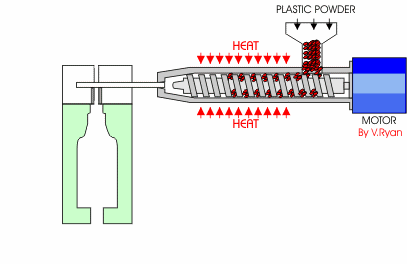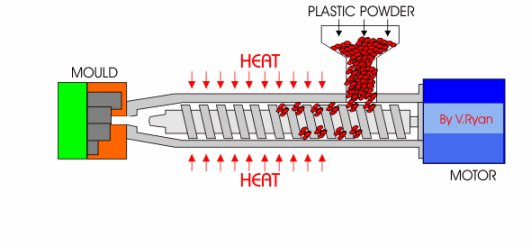COMPRESSION MOULDING:
- The manufacturing process generally used for processing thermosetting polymers.
- Advantages of compression moulding:
- Moderately complex parts can be produced over long production run times.
- Although there is some heavy machinery involved, start-up costs are relatively low; moulds are less expensive than those used in injection moulding.
- There is little waste material.
- Disadvantages of compression moulding:
- It is necessary to manufacture a preform.
- The process is restricted to products with low complexity.
--> Process = (STEP 1) A preformed 'slug' (compressed powder) of material is placed between the two halves of the mould.
(STEP 2) The mould is heated to a temperature that will allow the cross-links to form within the material.
(STEP 3) The mould is closed onto the preform and the pressure used will force out any excess material. The moulds are held closed under pressure at the required temperature for a period of time that is sufficient to allow all of the material o be 'cured', i.e all cross-links formed.
(STEP 4) When the mould is opened, the product can be ejected while it is still hot (it does not have to be cooled) and the process can begin again.
INJECTION MOULDING:
- This process is most commonly associated with thermoplastics and is used to produce complex three-dimensional shapes.
--> Process = (STEP 1) Plastic granules (plus any other additives and colours mixed with them0 are placed in the hopper. The granule mixture falls through the hopper onto the Archimedean screw.
(STEP 2) The screw is rotated via the motor and the gearbox. This action forces the polymer forwards towards the heaters, where it becomes softened to the point where it is ready to be injected into the mould.
(STEP 3) The hydraulic ram forces the softened polymer through the feedhole into the mould. Pressure from the ram ensures the mould cavity has been filled.
(STEP 4) When sufficient time has passed to allow the polymer to cool and solidify, the mould halves are opened. As they open, ejector pins are activated to release the product from the mould.
(STEP 5) Once emptied, the mould is then closed ready to begin another cycle.
- Advantages of injection moulding:
- Very complex 3-D shapes can be produced.
- High volumes can be produced with consistent quality.
- Metal inserts can be included in the item being produced.
-Disadvantages of injection moulding:
- Initial set-up costs are high.
- Moulds are expensive.
BLOW MOULDING:
- This process is used in the manufacture of bottles and other containers. Objects produced are usually hollow and have a narrow neck.
 --> Process = (STEP 1)
--> Process = (STEP 1) A tube of heated and softened polymer is extruded vertically downwards. This tube is called a Parison.
(STEP 2) The mould halves close, trapping the upper end of the parison, effectively sealing it.
(STEP 3) Hot air is then blown into the parison forcing it out to follow the shape of the mould.
(STEP 4) The mould effectively cools the polymer allowing it to be released from the mould.
(STEP 5) The mould halves are opened and the product is extracted.
- Advantages of blow moulding:
- Once set up, blow moulding is a rapid method of producing hollow objects with narrow necks.
- Non-circular shapes can be produced.
- Disadvantages of blow moulding:
- Moulds can be expensive.
- It's difficult to produce re-entrant shapes, i.e shapes that do not allow easy extraction from the mould, e.g a dovetail joint.
- Triangular-shaped bottles are difficult to produce.
ROTATIONAL MOULDING:
- It is used in the manufacture of 3-D hollow products, such as footballs, road cones and large storage tanks.
 --> Process =
--> Process = The machines have a number of arms that rotate about a fixed central point. Moulds are attached to the end of each arm and are rotated continuously. The only time the moulds do not rotate is when they are at the starting point and the end of the process.
(STEP 1) Once the moulds have been loaded with a precise weight of thermoplastic powder the mould halves are clamped together.
(STEP 2) The moulds are then rotated about the arm spindle and the whole arm is rotated towards a heated chamber where the thermoplastic material is heated to its melting point. The continuously rotating mould ensures that the thermoplastic covers all of the mould.
(STEP 3) The next stage of the process is the cooling chamber where the material is cooled ready to be extracted from the mould.
(STEP 4) The mould is then returned to the starting point where the mould halves are separated and the product removed.
- Advantages of rotational moulding:
- One-piece mouldings can be produced.
- It is ideal for both rigid, tough shapes and flexible shapes.
- A large range of sizes is possible, from small medical components to large storage tanks.
- Surface textures can be applied to the finished products from textures applied in the mould.
- Moulds ten to be cheaper than those for injection or blow moulding, since high pressures are not required.
- Cheaper moulds allow lower production runs.
- Disadvantage of rotational moulding:
- Only hollow shapes can be produced in this way. More complex 3-D shapes would either be blow moulded or injection moulded.




